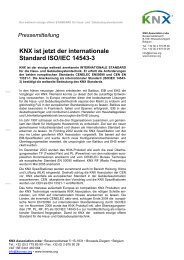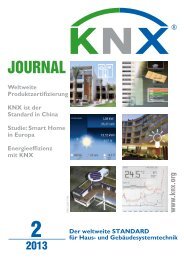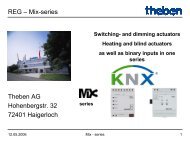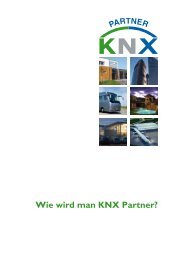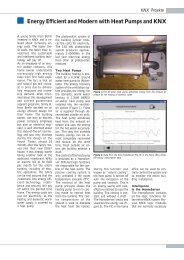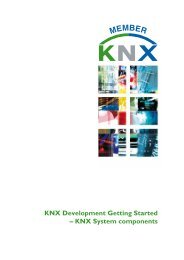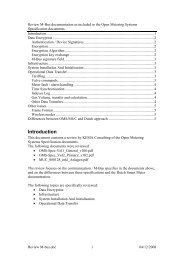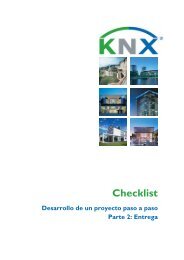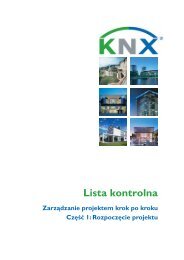KNX Journal 2011-1
KNX Journal 2011-1
KNX Journal 2011-1
Create successful ePaper yourself
Turn your PDF publications into a flip-book with our unique Google optimized e-Paper software.
Editorial<br />
stem. Building automation<br />
with <strong>KNX</strong> offers all kinds of<br />
benefits: a flexible electrical<br />
installation for changes of<br />
use and extensions, more<br />
efficiency in the management<br />
and maintenance of the building,<br />
increased security for<br />
material assets and people,<br />
a higher level of comfort and<br />
well-being in the workplace,<br />
both in public and residential<br />
buildings. The management<br />
of energy savings is therefore<br />
only one of these. The total<br />
investment costs are thus<br />
spread across many benefits.<br />
Once the installations and<br />
functions have been integrated,<br />
further reductions in the<br />
energy consumption can often<br />
be achieved simply through<br />
programming, without the<br />
need for additional hardware<br />
and installations.<br />
In the projects that have been<br />
put forward, almost all of<br />
them feature possible savings<br />
measures with <strong>KNX</strong> which<br />
often simultaneously serve<br />
comfort, safety and economical<br />
operational flow.<br />
Switching<br />
off and dimming<br />
Saving energy means switching<br />
the light off when you don’t<br />
need it. This sounds so simple<br />
but it is rarely achieved<br />
in practice in more extensive<br />
buildings with large numbers<br />
of people coming and going.<br />
In office buildings, schools,<br />
factories, warehouses, hotels,<br />
car parks and many other<br />
buildings, artificial lighting is<br />
left switched on for many<br />
reasons. In the case of building<br />
automation with <strong>KNX</strong>, the<br />
duty cycle can for example be<br />
adapted to the actual lighting<br />
requirement with the help of<br />
a timer program. This measure<br />
alone can achieve high<br />
savings which can be further<br />
optimised depending on the<br />
room use and building type,<br />
for example through using<br />
daylight and automatic cutoff<br />
when there is sufficient<br />
external brightness. A further<br />
enhancement of the automation<br />
is constant lighting<br />
control which guarantees a<br />
comfortable lux value at the<br />
workplace through optimum<br />
use of daylight.<br />
Presence-dependent and thus<br />
accurate demand-based control<br />
systems are increasingly<br />
being applied – ideal for staircases,<br />
corridors or other<br />
spontaneously used areas<br />
of the building. Lights with<br />
presence detectors can also<br />
be operated with increased<br />
energy efficiency in offices,<br />
schools etc. They then become<br />
elements of the room<br />
automation, are integrated<br />
with the blinds, room temperature<br />
control and ventilation<br />
and thus offer multiple<br />
benefits.<br />
Regulating the heating<br />
and cooling<br />
Electronic individual room<br />
temperature control promises<br />
a clear saving potential.<br />
It is therefore the most<br />
efficient method of using the<br />
heating and cooling energy<br />
generated via the heating<br />
system or air conditioning<br />
system. Demand-based energy<br />
use can be achieved via a<br />
timer program with a temperature<br />
profile or even via the<br />
presence signal. As the temperature<br />
variables of all the<br />
rooms are available centrally<br />
throughout the <strong>KNX</strong> system,<br />
heating and cooling energy<br />
can be generated according<br />
to demand and with a high<br />
level of efficiency.<br />
In modern, purpose-built<br />
buildings with glass façades,<br />
fully-automatic sun protection<br />
systems are indispensable.<br />
Their primary tasks are<br />
shading and cooling to ensure<br />
the well-being of the people<br />
in the building. As these<br />
are likewise controlled with<br />
<strong>KNX</strong>, additional functions for<br />
improving the energy efficiency<br />
are provided in combination<br />
with room temperature<br />
control and lighting control.<br />
For example: daylight redirection,<br />
use of solar energy<br />
in winter and automatic night<br />
cooling in the summer.<br />
From the perspective<br />
of energy consumption<br />
The interaction of all the<br />
trades in room and building<br />
automation contains a high<br />
optimisation potential. All<br />
the functions are linked in<br />
an energy and building management<br />
system. <strong>KNX</strong> offers<br />
optimum solutions with<br />
management and visualisation<br />
systems for this purpose.<br />
Further building technology<br />
systems are integrated via<br />
interfaces. All the data that is<br />
required for efficient building<br />
operation can be recorded,<br />
archived and visualised in a<br />
central location. The energy<br />
consumption data which has<br />
been processed is particularly<br />
interesting and forms the basis<br />
for further optimisation of<br />
the energy consumption. Moreover,<br />
all the functions can<br />
be operated and monitored<br />
centrally via the visualisation.<br />
A fault indication system increases<br />
the availability of the<br />
installation engineering. High<br />
energy consumption caused<br />
by faults can also be quickly<br />
rectified.<br />
Summary<br />
The <strong>KNX</strong> worldwide standard<br />
offers the best prerequisites<br />
for improving the energy<br />
efficiency in buildings. System<br />
integrators can choose<br />
suitable <strong>KNX</strong> bus devices for<br />
energy-saving functions in the<br />
different trades from almost<br />
7,000 certified products from<br />
more than 225 international<br />
manufacturers. Interconnected<br />
energy and building<br />
management systems are<br />
thus formed which allow energy<br />
flows to be controlled,<br />
regulated and monitored<br />
according to demand during<br />
operation. Practical applications<br />
are persuasive due to<br />
clear savings in energy costs.<br />
In comparison, measures for<br />
energy optimisation often pay<br />
off immediately.<br />
A low Energy Standard single Family Home/ Austria<br />
A new bioclimatic Office Building in Huesca/ Spain<br />
The yearly costs for heating of this 150 m² home are incredibly low;<br />
between 250 to 300.<br />
By the overall use of <strong>KNX</strong>, energy consumption in the building is<br />
reduced by 40 %.<br />
<strong>Journal</strong> 1/<strong>2011</strong><br />
5




